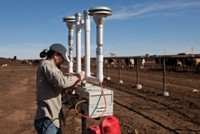Advertisement
Grab your lab coat. Let's get started
Welcome!
Welcome!
Create an account below to get 6 C&EN articles per month, receive newsletters and more - all free.
It seems this is your first time logging in online. Please enter the following information to continue.
As an ACS member you automatically get access to this site. All we need is few more details to create your reading experience.
Not you? Sign in with a different account.
Not you? Sign in with a different account.
ERROR 1
ERROR 1
ERROR 2
ERROR 2
ERROR 2
ERROR 2
ERROR 2
Password and Confirm password must match.
If you have an ACS member number, please enter it here so we can link this account to your membership. (optional)
ERROR 2
ACS values your privacy. By submitting your information, you are gaining access to C&EN and subscribing to our weekly newsletter. We use the information you provide to make your reading experience better, and we will never sell your data to third party members.
Pollution
Some types of trees excel at removing particles from polluted air
Wind tunnel studies suggest that silver birch and certain other tree species may be better than others at trapping roadside air pollution
by Lauren Gravitz, special to C&EN
June 6, 2019

Air pollution from diesel exhaust, brake dust, and other particles thrust into the air by cars on multilane highways has measurable effects on health—increasing the risk of asthma, heart disease, and other conditions. To try and trap that particulate matter, researchers have begun looking to trees. In a new study, scientists have found that certain tree species have leaves with features that make them good, albeit temporary, air filters for ultrafine particles, the smallest and most health-damaging class of particles with diameters less than 100 nm (Environ. Sci. Technol. 2019, DOI: 10.1021/acs.est.8b06629).
Barbara A. Maher of the University of Lancaster and her colleagues have been looking at whether trees might help mitigate the influence of ultrafine particles on health. Earlier research from her lab had shown that silver birch trees were good at capturing particles larger than 1 µm. Now they wanted to know whether it would also nab ultrafine particles and whether other tree species could do the same job.

The researchers created their own controlled, artificial roadway by attaching the tailpipe of a diesel vehicle to a small wind tunnel. They collected branches from nine tree species—silver birch, yew, elder, maple, ash, cherry, beach, hawthorn, and nettle—and washed the leaves to rid them of existing particles. Then they placed the branches inside the wind tunnel and exposed them to diesel exhaust for a total of 35 min, measuring air quality on either side of the branches every 7 min.
There was a huge range in particle-removal efficiency among the different species, with the best performing ones removing 70.5% (elder), 71.5% (yew), and 79% (silver birch) of the ultrafine particles. “At the microscale, the type of leaf—its structures and hairiness and leaflet size and topography—controls how efficient that leaf is in getting particles to deposit on the leaf’s surface,” Maher says. The furry leaves of a silver birch or the many small leaves of a yew contain more surface area, increasing the chance a particle will bump into it.
The measured efficiencies of the best performing species were four times as high as what earlier airflow modeling studies have suggested was possible. But those models haven’t taken species-specific differences into account.
One potential reason for the gap, says Jay Turner, an air quality engineer at Washington University in St. Louis, is that the densely packed branches of this wind tunnel experiment created a porous mat across a cross section of the tunnel. “That will likely have very different airflow compared to a tree out in the environment,” Turner says. Outside, air could flow around rather than through a hedge, especially if the vegetation is dense. Right now, he says, there’s not enough evidence that trees can increase particle removal in a real-world context more than incrementally.
Maher is testing that next. Earlier results with silver birch trees placed in front of houses along a busy roadside for 13 days showed slightly lower particle filtration efficiency than the wind tunnel, but not as low as computer modeling predicted. For her next experiment, she will be planting what she calls “tredges” (hedges made from tree species) along busy roads in Manchester, England, that abut primary schools. She will measure particle concentrations before tredge installation and post-installation on either side of the plants.
Even if the plan works, such hedges are still a stop-gap solution. At some point, the leaves become saturated with particles and less effective. Rain refreshes them, but it also washes the pollution off and into the soil, which then grows contaminated over time. “This is really only a temporary approach,” Maher says. But “if we can eliminate 50-60% of the particulate pollution in these schools, why shouldn’t we?”





Join the conversation
Contact the reporter
Submit a Letter to the Editor for publication
Engage with us on Twitter